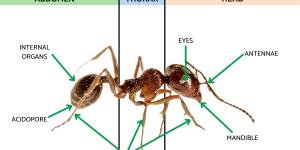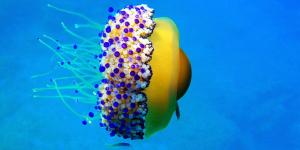Jellyfish Anatomy - Parts of a Jellyfish


Jellyfish anatomy is fairly unique in the animal kingdom. Although they share certain features with other cnidarians, there are parts of a jellyfish we cannot see outside of their phylum. These include the main body which is an umbrella-shaped bell, the manubrium that connects the mouth with the gastric cavity and the tentacles used for defense and predation.
Another important factor is that jellyfish anatomy changes depending on their developmental stage. As with other members of the phylum Cnidaria, the free-living phase of jellyfish is known as the medusa stage. This is when they are developed and sexually reproductive. When they are younger, they have the immobile polyp phase. Although they lack specialized organs like other more evolutionarily advanced animals, jellyfish are both intelligent and very well adapted to their environment. thedailyECO discovers more by looking at jellyfish anatomy, specifically the parts of a jellyfish and their functions.
Bell
Adult jellyfish take the form of a medusa. This is the animal with a bell-shaped body and tendrils which hand down from it. The bell is the main body of the jellyfish and it is so-called due to its appearance. It is umbrella shaped, although it fluctuates when swimming. For this reason, it is sometimes known as a hood since it is malleable like the hood of a cloak.
The part of a jellyfish known as the bell has a gelatinous consistency. This is thanks to a tissue known as mesoglea. it is generally transparent, although it may be brown, purple or even patterned in various ways. Some species can even be bioluminescent, meaning they are animals that produce their own light. Learn more about this ability in animals with our article on how fireflies produce light.
Jellyfish do not have many organs. The vital organs that keep the jellyfish functioning they do have are contained in the bell. They include the following:
- Gastric cavity: this is the equivalent of the digestive system where food is processed. The tissue that delimits the bell inwards to this system is called gastrodermis. The cavity is divided into four septa which are housed in a central stomach. Here the nutrients the jellyfish needs to survive are absorbed.
- Nervous network: also contained in the bell is the equivalent of the nervous system called the nervous network. This is where their primitive nerves are accommodated. These extend throughout the body and are responsible for the movement of the tissues.
- Sexual organs: the gonads are also contained in the bell. This is where the female or male gametes are found. Only in the medusa phase of a jellyfish do gonads present. They are not present in the polyp stage because it is not the sexual phase. In the moon jellyfish (Aurelia aurita) these gonads are visible through the ectodermis of the umbrela. They look like a flower with 4 petals or 4 circles joined at the ends.

Manubrium
A structure called the manubrium emerges from the bell which is shaped like a duct. Here is where the mouth is located. This is intended for feeding directed by specialized tentacles known as oral arms. Any undigested food is excreted back out of this orifice since jellyfish do not have anuses. The function of the manubrium is to connect the mouth with the gastric cavity to process food.

Tentacles
Jellyfish tentacles are extensions that hang downwards from the bell. They are one of the most indicative parts of a jellyfish, although all other cnidarians have them to varying degrees. Those closest to the mouth are the aforementioned oral arms. They are thicker and shorter in appearance than the other types of jellyfish tentacles.
The thinnest and longest tentacles are at the ends of the bell. They are often called stinging tentacles. In many types of jellyfish species they can be extremely long compared to the body. This increases the probability of catching more prey due to the area they cover.
The skin of the tentacles is covered by stinging cells called cnidocytes. These have a spine-like structure called cnidocilium, which activates the cnidocyte upon contact with any external object. This is when a barb is uncoiled from the cell to puncture and inject venom. The potency of the veonom varies depending on the species. In mild cases it can cause redness and irritation in humans, but it can be fatal in some species such as the Australian box jelly (Chironex fleckeri).
The oral tentacles serve to attract the prey to the mouth and paralyze it completely. This is in addition to the fact that near the gastric cavity they secrete enzymes to digest the food. The stings serve to both capture their own prey and as a defense against becoming prey themselves.

Rhopalia
The rhopalia can be found at the edge of the part of a jellyfish anatomy known as the bell. They have a sensory function. They consist of an ocellus that serves to detect changes in the surrounding light, as well as a statocyst that serves as a balance organ. This allows the jellyfish to orient itself, especially in terms of sea depth. The level of specialization of the ocellus depends on the species, with box jellyfish such as the sea wasp having the most advanced ocelli.

Other parts of a jellyfish
We have discovered the main parts of jellyfish anatomy, but there are many ither important characteristics of this cnidarian. They include the following:
- They don't have a head since the bell functions as both body and head at the same time.
- Jellyfish do not have conventional brains like other animal species and are considered relatively simple organisms. You can learn more with our article on whether jellyfish have brains.
- They do not actively hunt. Instead, they only wait for prey to come close enough to them to catch it with their tentacles. This is especially the case with jellyfish in the polyp stage which are sessile creatures that attach themselves to various underwater surfaces.
- Most jellyfish are harmless to humans, but many of them can be lethal to us. Only 5% of all species are potentially deadly to humans.
- 95% of their total body is made up of water and the rest is protein and collagen.
- To swim, they contract the bell to expel water and move, but most just let themselves be carried by the currents.
- They have radial symmetry, allowing them to respond to threats coming from any direction.
- Although they are basic in function and do not closely resemble those of other animals, jellyfish do have eyes. Jellyfish vision is very limited, but they do have spatial awareness.
- They have existed for 700 million years, making them the oldest complex animal on the planet.
- They have a cosmopolitan distribution and live throughout the world, including different depths. Learn more about cosmopolitan animal distribution in our related article.
Now you know more about the parts of jellyfish and their functions, you may want to learn more about another type of cnidarian species. You can do this with our article on gorgonian coral and its characteristics.
If you want to read similar articles to Jellyfish Anatomy - Parts of a Jellyfish, we recommend you visit our Facts about animals category.
- Beatty, R., Beer, A., & Deeming, C. (2010). The book of nature. Great Britain: Dorling Kindersley.
- Audesirk, T., Audesirk, G., Byers, B. E., Escalona García, H. J., & Escalona García, R. L. (2003). Biology: life on earth. Puerto Rico: Pearson Education.









